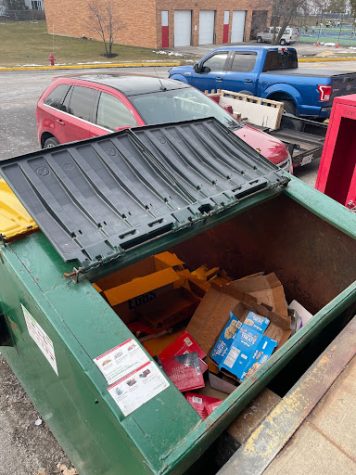UN climate report paints grim picture for planet’s future, but hope remains if action taken
October 18, 2021
On Aug. 6, the Intergovernmental Panel on Climate Change (IPCC), a United Nations body, released a major report on climate change. While climate reports might seem to come out frequently, this report is of major significance because it comes from a UN body, which means several countries signed off on a report that said the following: climate change is bad, it’s going to get worse if drastic measures aren’t taken and it’s “unequivocal that human influence has warmed the atmosphere, ocean and land.”
The Climate Today
The first part of the climate report lays out the damage already done to the planet. Each decade is hotter than the last, but how does warming even affect the planet? Glacier melting is one answer; this causes sea levels to rise and affects coastal communities due to the loss of shorelines.
The report stated, “Human influence is very likely the main driver of the global retreat of glaciers since the 1990s and the decrease in Arctic sea ice area between 1979–1988 and 2010–2019 (about 40 percent in September and about 10 percent in March).”
Another effect of warming is extreme weather of which we’ve been seeing more of lately– for example, the heat waves that swept the U.S. over the summer and the flooding in Europe that also took place over the summer.
The report confirms this, saying, “Human-induced climate change is already affecting many weather and climate extremes in every region across the globe. Evidence of observed changes in extremes, such as heatwaves, heavy precipitation, droughts, and tropical cyclones, and, in particular, their attribution to human influence, has strengthened since AR5 [a fifth climate change assessment report by IPCC published in 2014].”
Possible Outcomes for the Climate
There are ways to repair the environment (for instance, some ocean ecosystems can be repaired), but other damage is irreversible.
Either way, the climate is guaranteed to warm for the next 30 years, with the report stating, “Global surface temperature will continue to increase until at least the mid-century under all emissions scenarios considered. Global warming of 1.5°C and 2°C will be exceeded during the 21st century unless deep reductions in CO2 and other greenhouse gas emissions occur in the coming decades.”
With continued warming, all the effects laid out above will continue to get worse, the report shows. The worst-case scenario is the earth warming 3°C or 4°C; keep in mind, though, the “best-case scenario” here is still devastating for the planet.
About the effects of further warming, the report states, “With every additional increment of global warming, changes in extremes continue to become larger. For example, every additional 0.5°C of global warming causes clearly discernible increases in the intensity and frequency of hot extremes, including heatwaves (very likely), and heavy precipitation (high confidence), as well as agricultural and ecological droughts in some regions (high confidence).”
However, the report does note that not all is lost provided the world governments take steps to reduce CO2 emissions.
“I do think there is [hope] if everyone takes the issue seriously,” Jamie Brongiel, science teacher, said. “There are already many mitigation measures already in place that have shown to be helping.”
What Can Be Done to Help
MHS has already taken measures to be more environmentally conscientious.
“The C-wing took advantage of a lot of things,” Head of Maintenance Kevin Quinn said. “There are occupancy sensors in there to turn down the electricity at night. Going forward, there’s going to be a lot more things incorporated into the expansion of this school.”
Students can also think about how they influence the world as consumers since consumers drive supply and demand; therefore, consumers have the ability to take away the demand for products that harm the environment by the way they are produced (ex. where/how clothing is made). Consumers can also not choose the fastest shipping option if the item is not needed immediately.
“We need to understand how our carbon footprint is created,” Quinn said. “That’s the challenge– is what do we do? What are our day-to-day actions that are causing the greenhouse gasses? What can we do to minimize that, to restrict it? We can’t go back and change anything that’s been done over the course of time, but we can certainly start now.”
Brongiel also echoed this idea that climate change comes down to what individuals are doing.
“Personal actions matter,” she said. “If everyone reduced their carbon footprint, then the overall carbon footprint would be reduced as well.”
Another day-to-day action that would minimize one’s carbon footprint is eating less or no meat.
An Oct. 1, 2019, New York Times article titled “The Real Problem with Beef” by Aaron E. Carroll stated, “Almost 30 percent of the world’s ice-free land is used to raise livestock. We grow a lot of crops to feed animals, and we cut down a lot of forests to do that. — Cows also put out an enormous amount of methane, causing almost 10 percent of anthropogenic greenhouse gas emissions and contributing to climate change.”
Additionally, people can minimize their carbon footprint by carpooling or not driving to places when possible.
But some say the most important step a person can take to help counter the effects of climate change is through education about what’s going on and how to spread awareness.
Darby Schwerman, a freshman member of the school’s Environmental Club, said, “I think you can honestly try and find more information on it yourself and be interested in environmental issues.”
As Quinn acknowledged, part of the educational process is thinking about how climate change might also disproportionately affect those who don’t have the resources to resist its effects.
For instance, when heat waves sweep a nation, many areas might not have air conditioning units– whether because they don’t usually need them given the natural weather pattern for that area or they can’t afford them. As a result, only the people who can afford to purchase one at a moment’s notice are able to keep cool.
“One of the goals, and I really love this part of the report, is to impact these changes, but it has to be fair,” Quinn said. “It has to be equitable across. It has a more holistic view of it because sometimes when we try to put tighter controls on our emissions, it impacts people who can least afford to be impacted.”


